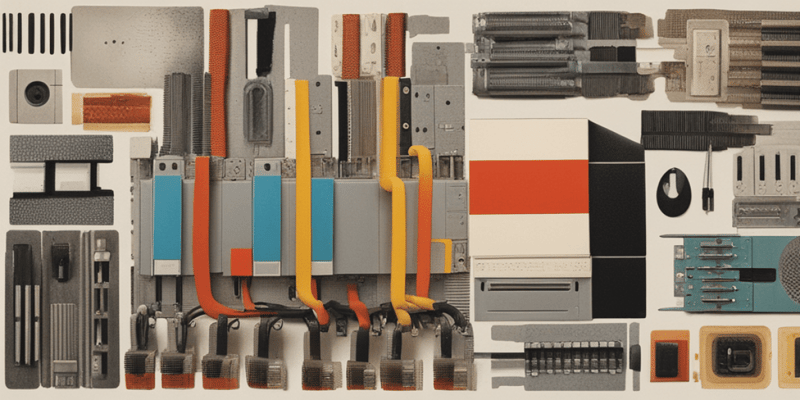30 Questions
What is a disadvantage of bus topology mentioned in the text?
Extensive cabling
How does a ring topology differ from a bus topology?
Data flows unidirectionally
What happens if two nodes in a bus topology send messages simultaneously?
The signals collide
How is reconfiguration in bus topology described in the text?
Adding new devices slows down the network
What is attenuation in the context of communication networks?
Loss of signal leading to issues
Which access method is most common in ring topology?
Token passing
What is a key advantage of mesh topology?
Reliability
Why is managing mesh topology networks challenging?
Large size and difficulty in maintenance
Which factor hinders the efficiency of a mesh topology network?
High redundant connections
What characterizes hybrid topology?
Combination of various topologies
In hybrid topology, what happens when similar topologies are connected?
Forms hybrid topology
What distinguishes hybrid topology from mesh topology?
Combination of different topologies
What is the main function of routers in a network?
Data encapsulation and de-capsulation process
How do routers provide redundancy in a network?
By working in master and slave mode
What is the role of a gateway in networking?
Connect two networks implementing different protocols
How is a gateway described in terms of its intelligence?
Intelligent in working, error control, and packet routing
What advantage does a gateway offer in network connections?
Connecting devices of different network structures
Which network device works primarily by creating different paths to forward data?
Router
Which wiring scheme is the most common for Ethernet cables?
T-568B
When is a crossover Ethernet cable used?
For computer-to-computer connections without a router, hub, or switch
In a hub-based network, how is data transmitted to other devices?
Data is broadcasted to all devices connected to the hub
What is the function of a passive hub in a network?
Determine bugs and faulty hardware
Which type of hub treats all connected devices equally in terms of network access?
Passive Hub
What type of cable would you use to directly connect two computers without any networking devices in between?
Crossover Ethernet Cable
What is the primary function of a repeater in a network?
Amplifying attenuated signals
Why do repeaters pose a limitation on the length of LANs and coverage area of cellular networks?
They amplify attenuated signals
Which type of repeater can reconstruct distorted signals?
Digital Repeaters
What differentiates wired repeaters from wireless repeaters?
The type of networks they are used in
What can digital repeaters do that analog repeaters cannot?
Reconstruct distorted signals
How do repeaters assist in forming a large single LAN?
By amplifying and retransmitting attenuated signals
Study Notes
Bus Topology
- A bus topology requires a lot of cabling, making it simpler but still extensive.
- Difficult troubleshooting is required to determine cable faults.
- Signal interference can occur when two nodes send messages simultaneously.
- Reconfiguration is difficult, slowing down the network when adding new devices.
- Attenuation leads to communication issues, requiring repeaters to regenerate the signal.
Ring Topology
- A ring topology is similar to a bus topology, but with connected ends.
- Data flows in one direction (unidirectional) in a single loop.
- Each node is connected to another node, with no termination point.
- Data flows in a clockwise direction.
- The most common access method is token passing.
Mesh Topology
Advantages
- Reliable: If one link breaks, communication between connected computers won't be affected.
- Fast communication between nodes.
- Easier reconfiguration: Adding new devices won't disrupt communication between other devices.
Disadvantages
- High cost due to a large number of connected devices and transmission media.
- Management is difficult due to the large size of the network.
- Redundant connections reduce network efficiency.
Hybrid Topology
- A combination of different topologies.
- A connection between different links and nodes to transfer data.
- Two or more different topologies combined, but similar topologies connected together isn't Hybrid topology.
RJ 45 Connector
- The T-568B wiring scheme is the most common, but some devices support T-568A.
- Crossover Ethernet cables have a T-568A connector on one end and a T-568B connector on the other.
- These cables are used for direct computer-to-computer connections without a router, hub, or switch.
HUB
- A hub is a basic networking device connecting multiple devices on a local network.
- All devices share the same bandwidth, and every device has equal access to the network.
- There are three types of hubs: Passive, Active, and Intelligent.
Repeater
- Electrical signals get attenuated depending on the channel or technology.
- Repeaters amplify the attenuated signal and retransmit it.
- Digital repeaters can reconstruct distorted signals.
- Repeaters connect two LANs to form a large single LAN.
Types of Repeaters
- Analog Repeaters: Amplify analog signals.
- Digital Repeaters: Reconstruct distorted signals.
- Wired Repeaters: Used in wired LANs.
- Wireless Repeaters: Used in wireless LANs and cellular networks.
Routers
- Filter out unwanted interference and perform data encapsulation and de-capsulation.
- Provide redundancy, working in master and slave mode.
- Allow connecting multiple LAN and WAN.
- Create various paths to forward data.
Gateway
- Connects two networks with different transmission protocols.
- A node on a network serving as an entrance to another network.
- Intelligent device with filtering capabilities, error control, data packet routing, and transmission speed control.
Advantages of Gateway
- Connects devices of two different networks with dissimilar structures.
- Intelligent device with filtering capabilities.
- Controls both collisions and broadcast domains.
Test your knowledge on the T-568A and T-568B wiring schemes for RJ-45 connectors commonly used in networking. Learn about the differences between T-568A and T-568B, as well as when to use crossover Ethernet cables.
Make Your Own Quizzes and Flashcards
Convert your notes into interactive study material.
